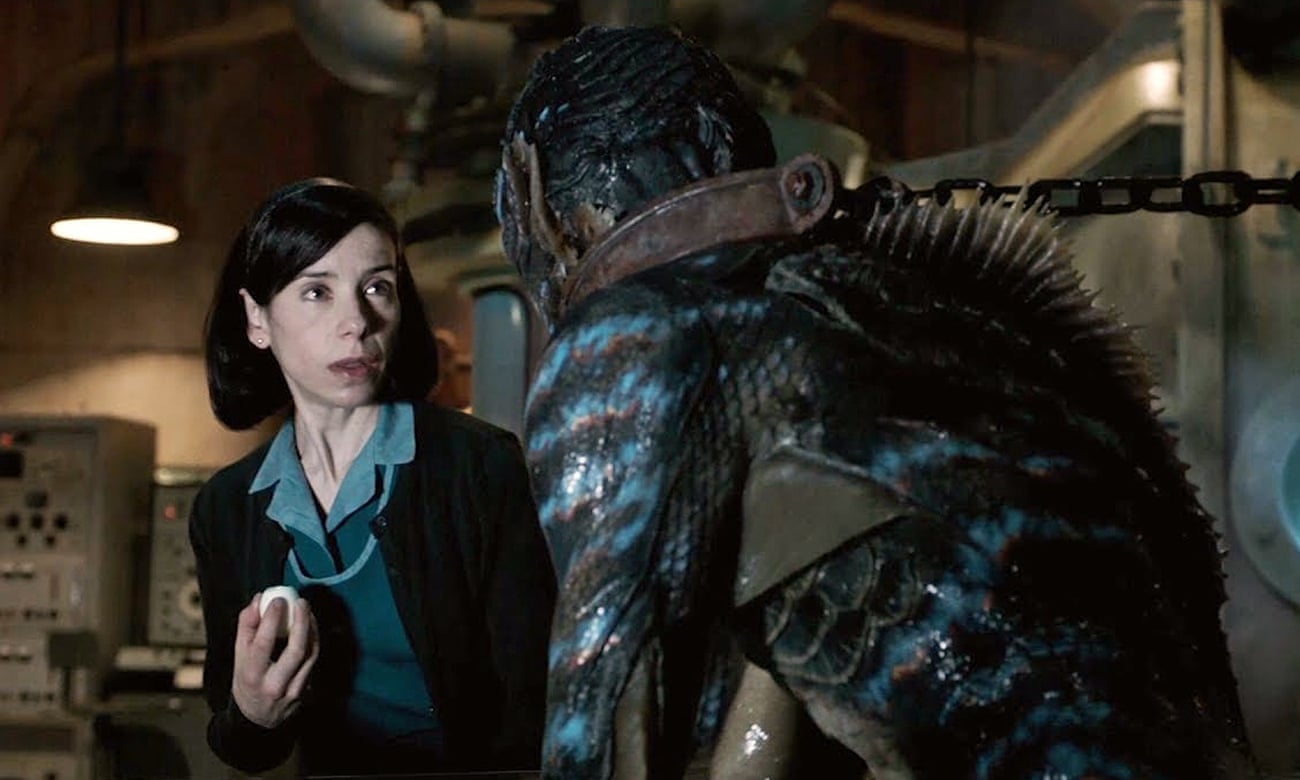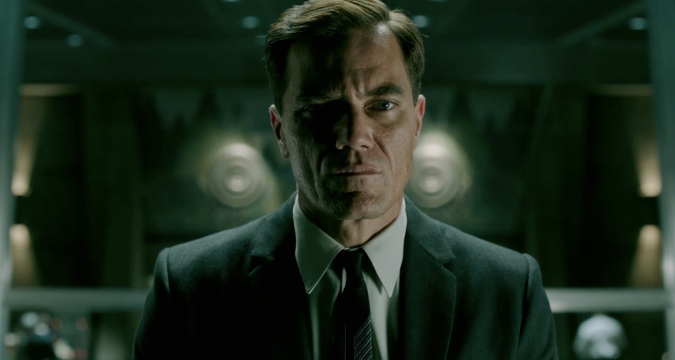The Shape of Water Film Review
Beauty and the Beast
While it's well known that he hasn't shied away from the cinematic spotlight in making big-budget hits of Hellboy and Pacific Rim, it's arguable to state that Guillermo Del Toro does seemingly fit within the confines of a contemporary auteur. From the exotic and lavishly outlook that's depicted within Pan's Labyrinth to the ever omnipotent horrific aspects that are elaborately and imaginatively emphasised in Crimson Peak, there's no other director quite like Del Toro who ambitiously, yet successfully, creates premises that are fine tuned with distinctive detail and seamlessly amalgamates the realism with the fantastical. His efforts in fusing dreams, nightmares and realism is subtly effective; forever pulling your gaze into these worlds and making you feel safe from whatever problems you may have. It's the illusive manner in which he makes horrific elements satisfying to look at that makes the said director's films that much more interesting to perceive. Much of the same can be said and seen through his latest filmic venture, The Shape of Water; a visually ravishing and sensory experience that not only upholds the distinguishing strangeness that audiences have come to know of the aforesaid film-maker, but it's a Beauty and the Beast fable that beautifully excels through its visualisation and characterisation alone...
Taking place in Baltimore, 1962, where the Civil Rights movement and the anxiety/threat of Soviet supremacy are bubbling in the background, The Shape of Water centralises its story around Elisa (Sally Hawkins), a muted and isolated woman who works as a cleaning lady in a hidden, high-security government laboratory. Whilst working on a night-shift with Zelda (Octavia Spencer), Elisa's life changes forever when she discovers the lab's classified secret, a mysterious half-man, half-lizard, scaled-looking creature from South America that lives under a water tank. When Elisa spots the creature and notices how horribly it's being treated by Strickland (Michael Shannon) and the other government scientists, she tries to connect with him and develop a unique bond that would see them become more than just friends. As they get to know each other however, Elisa learns that the creatures fate and very survival solely lies in her hands...
If there's one negligence to The Shape of Water that ever-so-slightly hinders the fairly bristly pace of the structure, are the sequences that break away from Elisa's perspective; scenes where the attention is focused on the character of Giles. As much as Richard Jenkins' character helps to flourish the persona of Elisa, as well as establish one of Del Toro's themes of escapism as mentioned before, the sequences in which we see Giles either trying to romantically connect with the guy who makes the pies or proposing his illustrations to a person who conclusively becomes uninterested in said characters painting ability, it can subtly stagnate the flow of the central premise. Throughout its entirety, there are reverent homages to Mary Shelly's Frankenstein, Steven Spielberg's E.T. and even Jean-Pierre Jeunet's Amélie, with the way in which Elisa visually resembles Audrey Tatou's acknowledged character and how the mise-en-scène upholds a familiar colour aesthetic. Yet, for all its majesty in providing a moving romanticism, much of the tension and drama that's weaved in with the formalities can be at times disrupted by events that could have been disregarded.
Despite this arguable hindrance of the structure, at the heart of The Shape of Water's peculiar essence are the central performances of Sally Hawkins, Richard Jenkins, Octavia Spencer and Michael Shannon. In being mute throughout the total run-time, Hawkins gives a career-best performance with her sensual, superlative and vulnerable portrayal as Elisa who's facial expressions imbue more meaning and charisma than any other actor/actress spouting a line of dialogue. Naturally enacting roles that are quiet and timid, Hawkins, mainly through the expressive facial expressions and indicative hand gestures, steals the screen here by performing a complex role that only comes along once in a lifetime, and meets it with the performance of one. For those who are unacquainted with the said actress, it's reasonable to suspect that Hawkins really is a mute which is something that not a lot of screen-artists can seemingly pull-off; she uses every muscle in the facial expressions to give us a woman who exists without sound, but who's emotions are made vividly clear. Similar connotations can be made of Jenkins' enactment as Giles, who similarly possesses a bold side that is simply presented to the audience. However as mentioned before, while both Elisa and Giles both have their cagey sides, with Elisa showcasing herself to be a enthusiastically sexual being and Giles obsessed with a love-life that doesn't extend beyond gentle flirtations, it's their destined encounter with this seaman (portrayed by Doug Jones) which sets these characters free from their unhinged lives. Equally as important to see on screen is Michael Shannon's performance as the fearsome and corridor-prowling Strickland who styles himself as the monsters's tormentor-in-chief. "That thing we keep in their is an affront" he clamours to the cleaners. While it's a somewhat familiar role to see Shannon perform, having enacted characters in the forms of Rick Carver from 99 Homes and General Zod from Man of Steel, his performance as the racist and sexist Strickland is fairly intimidating and isn't seen in a way that distracts from the poetry that Del Toro is trying to emphasise.
From the small sequences to the imperative and tense moments that are predictably placed in a formulaic third act, if there's one profound quality to admire alongside the strong performances that make-up The Shape of Water, it's the ensnaring production design which keeps you invested and how realism and fantasy seamlessly merge together in a perfect and artistic unison. Resembling the classical and underwater tone depicted in many of the BioShock video-games, Del Toro likewise beguiles our imagination with a teal/ocean-esque colour aesthetic that culminates every interior and exterior and makes us feel as though we've dived into a hallucinogenic dream-state. From Dan Lausten's luminous cinematography that effortlessly manoeuvres across the bewildering dream-scape to Alexandre Desplat's elegantly swooning musical score, Del Toro once again produces exquisite production design that leaps off-the-screen in an effective and decorative manner.
While his preceding filmic endeavour of Crimson Peak saw Del Toro falter in delivering a premise that wasn't of the distinctive standard that was set in the said directors varying filmography, his efforts in constructing The Shape of Water see's the famed Mexican director go back to his fantastical routes and stands to be one of his best features, alongside Pan's Labyrinth. On multiple viewings, the thirteen Oscar-nominated feature will grow to become more and more impactful as it boats an amalgamating visual style and strong cast that delivers a richness to be savoured. To put it simply, it's immersive cinemas at its very finest...
On that note, it's time for me to end this film review. As always everyone, thank you for reading my latest film review of Guillermo Del Toro's The Shape of Water and I hope you've all enjoyed the read! 😉 If you have an opinion on either the film or on this review, you're more than welcome to comment down below. For either later this week or the week-after, I'll either bring you a review or Ryan Coogler's Black Panther or an analysis of retro feature. Thank you once again for reading this week's Blog Post and I hope you're all having a great week! Adieu! 😄👋👾🌊🦎👫💖
8/10 - Alex Rabbitte




Comments
Post a Comment